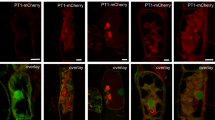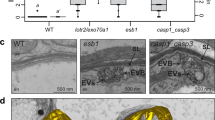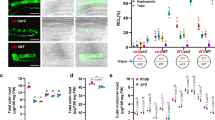Abstract
During arbuscular mycorrhizal (AM) symbiosis, cells within the root cortex develop a matrix-filled apoplastic compartment in which differentiated AM fungal hyphae called arbuscules reside. Development of the compartment occurs rapidly, coincident with intracellular penetration and rapid branching of the fungal hypha, and it requires much of the plant cell’s secretory machinery to generate the periarbuscular membrane that delimits the compartment. Despite recent advances, our understanding of the development of the periarbuscular membrane and the transfer of molecules across the symbiotic interface is limited. Here, using electron microscopy and tomography, we reveal that the periarbuscular matrix contains two types of membrane-bound compartments. We propose that one of these arises as a consequence of biogenesis of the periarbuscular membrane and may facilitate movement of molecules between symbiotic partners. Additionally, we show that the arbuscule contains massive arrays of membrane tubules located between the protoplast and the cell wall. We speculate that these tubules may provide the absorptive capacity needed for nutrient assimilation and possibly water absorption to enable rapid hyphal expansion.
This is a preview of subscription content, access via your institution
Access options
Access Nature and 54 other Nature Portfolio journals
Get Nature+, our best-value online-access subscription
$29.99 / 30 days
cancel any time
Subscribe to this journal
Receive 12 digital issues and online access to articles
$119.00 per year
only $9.92 per issue
Buy this article
- Purchase on Springer Link
- Instant access to full article PDF
Prices may be subject to local taxes which are calculated during checkout






Similar content being viewed by others
Data Availability
The data that support the findings of this study are available from the corresponding author upon request.
References
Gutjahr, C. & Parniske, M. in Annual Review of Cell and Developmental Biology Vol. 29 (ed. Schekman, R.) 593–617 (Annual Reviews, Palo Alto, 2013).
Harrison, M. J. & Ivanov, S. Exocytosis for endosymbiosis: membrane trafficking pathways for development of symbiotic membrane compartments. Curr. Opin. Plant Biol. 38, 101–108 (2017).
MacLean, A. M., Bravo, A. & Harrison, M. J. Plant signaling and metabolic pathways enabling arbuscular mycorrhizal symbiosis. Plant Cell 29, 2319–2335 (2017).
Bonfante-Fasolo, P., Vian, B., Perotto, S., Faccio, A. & Knox, J. P. Cellulose and pectin localization in roots of mycorrhizal Allium porrum: labelling continuity between host cell wall and interfacial material. Planta 180, 537–547 (1990).
Bonfante, P. & Perotto, S. Strategies of arbuscular mycorrhizal fungi when infecting host plants. New Phytol. 130, 3–21 (1995).
Cox, G. C. & Sanders, F. E. Ultrastructure of the host-fungus interface in a vesicular-arbuscular mycorrhiza. New Phytol. 73, 901–912 (1974).
Dexheimer, J., Gianinazzi, S. & Gianinazzi-Pearson, V. Ultrastructural cytochemistry of the host-fungus interfaces in the endomycorrhizal association Glomus mosseae/Allium cepa. Z. Pflanzenphysiol. 92, 191–206 (1979).
Bonfante-Fasolo, P. in VA Mycorrhizae (eds Powell, C. L. & Bagyaraj, D. J.) 5–33 (CRC, Boca Raton, 1984).
Dexheimer, J., Marx, C., Gianinazzipearson, V. & Gianinazzi, S. Ultracytological studies of plasmalemma formations produced by host and fungus in vesicular arbuscular mycorrhizae. Cytologia 50, 461–471 (1985).
Bracker, C. E. Ultrastructure of fungi. Annu. Rev. Phytopathol. 5, 343–372 (1967).
Marchant, R. & Moore, R. T. Lomasomes and plasmalemmasomes in fungi. Protoplasma 76, 235–247 (1973).
Gianinazzi-Pearson, V., Dexheimer, J., Gianinazzi, S. & Jeanmaire, C. Plasmalemma structure and function in endomycorrhizal symbioses. Z. Pflanzenphysiol. 114, 201–205 (1984).
Pumplin, N., Zhang, X., Noar, R. D. & Harrison, M. J. Polar localization of a symbiosis-specific phosphate transporter is mediated by a transient reorientation of secretion. Proc. Natl Acad. Sci. USA 109, E665–E672 (2012).
Genre, A., Chabaud, M., Faccio, A., Barker, D. G. & Bonfante, P. Prepenetration apparatus assembly precedes and predicts the colonization patterns of arbuscular mycorrhizal fungus within the root cortex of both Medicago truncatula and Daucus carota. Plant Cell 20, 1407–1420 (2008).
Zhang, X. C., Pumplin, N., Ivanov, S. & Harrison, M. J. EXO70I Is required for development of a sub-domain of the periarbuscular membrane during arbuscular mycorrhizal symbiosis. Curr. Biol. 25, 2189–2195 (2015).
Ivanov, S. et al. Rhizobium-legume symbiosis shares an exocytotic pathway required for arbuscule formation. Proc. Natl Acad. Sci. USA 109, 8316–8321 (2012).
Huisman, R. et al. A symbiosis-dedicated SYNTAXIN OF PLANTS 13II isoform controls the formation of a stable host-microbe interface in symbiosis. New Phytol. 211, 1338–1351 (2016).
Pan, H. et al. A symbiotic SNARE protein generated by alternative termination of transcription. Nat. Plants 2, 15197 (2016).
Javot, H., Penmetsa, R. V., Terzaghi, N., Cook, D. R. & Harrison, M. J. A. Medicago truncatula phosphate transporter indispensable for the arbuscular mycorrhizal symbiosis. Proc. Natl Acad. Sci. USA 104, 1720–1725 (2007).
Yang, S. Y. et al. Nonredundant regulation of rice arbuscular mycorrhizal symbiosis by two members of the phosphate transporter1 gene family. Plant Cell 24, 4236–4251 (2012).
Krajinski, F. et al. The H+-ATPase HA1 of Medicago truncatula Is essential for phosphate transport and plant growth during arbuscular mycorrhizal symbiosis. Plant Cell 26, 1808–1817 (2014).
Wang, E. T. et al. A H+-ATPase that energizes nutrient uptake during mycorrhizal symbioses in rice and Medicago truncatula. Plant Cell 26, 1818–1830 (2014).
Wewer, V., Brands, M. & Doermann, P. Fatty acid synthesis and lipid metabolism in the obligate biotrophic fungus Rhizophagus irregularis during mycorrhization of Lotus japonicus. Plant J. 79, 398–412 (2014).
Bravo, A., Brands, M., Wewer, V., Doermann, P. & Harrison, M. J. Arbuscular mycorrhiza-specific enzymes FatM and RAM2 fine tune lipid biosynthesis to promote development of arbuscular mycorrhiza. New Phytol. 214, 1631–1645 (2017).
Jiang, Y. et al. Plants transfer lipids to sustain colonization by mutualistic mycorrhizal and parasitic fungi. Science 356, 1172–1175 (2017).
Keymer, A. et al. Lipid transfer from plants to arbuscular mycorrhiza fungi. eLife 6, e29107 (2017).
Segui-Simarro, J. M., Otegui, M. S., Austin, J. R., II & Staehelin, L. A. in Plant Cell Monographs Vol. 9 (eds Hong, Z. & Verma, D. P. S.) 251–287 (Springer, Berlin, 2008).
Otegui, M. S., Mastronarde, D. N., Kang, B. H., Bednarek, S. Y. & Staehelin, L. A. Three-dimensional analysis of syncytial-type cell plates during endosperm cellularization visualized by high resolution electron tomography. Plant Cell 13, 2033–2051 (2001).
Nicolas, W. J. et al. Architecture and permeability of post-cytokinesis plasmodesmata lacking cytoplasmic sleeves. Nat. Plants 3, 17082 (2017).
Roth, R. et al. Nat. Plants https://doi.org/10.1038/s41477-019-0365-4 (2019).
Toth, R. & Miller, R. M. Dynamics of arbuscule development and degeneration in a Zea mays mycorrhiza. Am. J. Bot. 71, 449–460 (1984).
Ivanov, S. & Harrison, M. J. A set of fluorescent protein-based markers expressed from constitutive and arbuscular mycorrhiza-inducible promoters to label organelles, membranes and cytoskeletal elements in Medicago truncatula. Plant J. 80, 1151–1163 (2014).
Harrison, M. J., Dewbre, G. R. & Liu, J. A phosphate transporter from Medicago truncatula involved in the acquisition of phosphate released by arbuscular mycorrhizal fungi. Plant Cell 14, 2413–2429 (2002).
de Boer, P., Hoogenboom, J. P. & Giepmans, B. N. G. Correlated light and electron microscopy: ultrastructure lights up! Nat. Methods 12, 503–513 (2015).
Kellenberger, E. in Cryotechniquesin Biological Electron Microscopy (eds Steinbrecht, R. A. & Zierold, K.) 149–172 (Springer, Berlin, 1987).
Gilkey, J. C. & Staehelin, A. L. Advances in ultrarapid freezing for the preservation of cellular ultrastructure. J. Electron Microsc. Tech. 3, 177–210 (1986).
Alexander, T., Toth, R., Meier, R. & Weber, H. C. Dynamics of arbuscule development and degeneration in onion, bean, and tomato with reference to vesicular–arbuscular mycorrhizae in grasses. Can. J. Bot. 67, 2505–2513 (1989).
Genre, A., Chabaud, M., Timmers, T., Bonfante, P. & Barker, D. G. Arbuscular mycorrhizal fungi elicit a novel intracellular apparatus in Medicago truncatula root epidermal cells before infection. Plant Cell 17, 3489–3499 (2005).
Samuels, A. L., Giddings, T. H. & Staehelin, L. A. Cytokinesis in tobacco BY-2 and root-tip cells—a new model of cell plate formation in higher plants. J. Cell Biol. 130, 1345–1357 (1995).
Drakakaki, G. Polysaccharide deposition during cytokinesis: challenges and future perspectives. Plant Sci. 236, 177–184 (2015).
Wolf, J. M. & Casadevall, A. Challenges posed by extracellular vesicles from eukaryotic microbes. Curr. Opin. Microbiol. 22, 73–78 (2014).
Cai, Q. et al. Plants send small RNAs in extracellular vesicles to fungal pathogen to silence virulence genes. Science 360, 1126–1129 (2018).
Lo Presti, L. & Kahmann, R. How filamentous plant pathogen effectors are translocated to host cells. Curr. Opin. Plant Biol. 38, 19–24 (2017).
Rutter, B. D. & Innes, R. W. Extracellular vesicles isolated from the leaf apoplast carry stress-response proteins. Plant Physiol. 173, 728–741 (2017).
Hansen, G. H., Niels-Christiansen, L. L., Immerdal, L. & Danielsen, E. M. Scavenger receptor class B type I (SR-BI) in pig enterocytes: trafficking from the brush border to lipid droplets during fat absorption. Gut 52, 1424–1431 (2003).
Crawley, S. W., Mooseker, M. S. & Tyska, M. J. Shaping the intestinal brush border. Journal of Cell Biology 207, 441–451 (2014).
Sauvanet, C., Wayt, J., Pelaseyed, T. & Bretscher, A. in Annual Review of Cell and Developmental Biology Vol. 31 (ed. Schekman, R.) 593–621 (Annual Reviews, Palo Alto, 2015).
Fok, A. K. et al. The vacuolar-ATPase of Paramecium multimicronucleatum: gene structure of the B subunit and the dynamics of the V-ATPase-rich osmoregulatory membranes. J. Eukaryot. Microbiol. 49, 185–196 (2002).
Bartnicki-Garcia, S., Bracker, C. E., Gierz, G., Lopez-Franco, R. & Lu, H. S. Mapping the growth of fungal hyphae: orthogonal cell wall expansion during tip growth and the role of turgor. Biophys. J. 79, 2382–2390 (2000).
Tayagui, A., Sun, Y. L., Collings, D. A., Garrill, A. & Nock, V. An elastomeric micropillar platform for the study of protrusive forces in hyphal invasion. Lab. Chip. 17, 3643–3653 (2017).
Boisson-Dernier, A. et al. Agrobacterium rhizogenes-transformed roots of Medicago truncatula for the study of nitrogen-fixing and endomycorrhizal symbiotic associations. Mol. Plant-Microbe Interact. 14, 695–700 (2001).
Hong, J. J. et al. Diversity of morphology and function in arbuscular mycorrhizal symbioses in Brachypodium distachyon. Planta 236, 851–865 (2012).
Austin, J. R. in Arabidopsis Protocols Vol. 1062 (eds Sanchez-Serrano, J. & Salinas, J.) 473–486 (Humana Press, Totowa, 2015).
Hickey, W. J., Shetty, A. R., Massey, R. J., Toso, D. B. & Austin, J. Three-dimensional bright-field scanning transmission electron microscopy elucidate novel nanostructure in microbial biofilms. J. Microsc. 265, 3–10 (2017).
Ladinsky, M. S., Mastronarde, D. N., McIntosh, J. R., Howell, K. E. & Staehelin, L. A. Golgi structure in three dimensions: functional insights from the normal rat kidney cell. J. Cell Biol. 144, 1135–1149 (1999).
Kremer, J. R., Mastronarde, D. N. & McIntosh, J. R. Computer visualization of three-dimensional image data using IMOD. J. Struct. Biol. 116, 71–76 (1996).
Pumplin, N. & Harrison, M. J. Live-cell imaging reveals periarbuscular membrane domains and organelle location in Medicago truncatula roots during arbuscular mycorrhizal symbiosis. Plant Physiol. 151, 809–819 (2009).
Acknowledgements
Financial support for this project was provided by the U.S. National Science Foundation grant no. IOS-1353367 and by the TRIAD Foundation. Confocal microscopy was carried out in the BTI Plant Cell Imaging Center (NSF DBI-0618969). Electron microscopy was carried out in the Imaging and Microscopy Facility at the Danforth Plant Science Center and at the Cornell Center for Materials Research Shared Facilities (the latter is supported through the NSF MRSEC program (DMR-1719875)). Electron microscopy for 3D electron tomography was undertaken at the Advanced Electron Microscopy facility at The University of Chicago.
Author information
Authors and Affiliations
Contributions
All authors conceived the experiments and analysed data; S.I., R.H.B. and J.A. carried out experiments; all authors wrote the manuscript.
Corresponding author
Ethics declarations
Competing interests
The authors declare no competing interests.
Additional information
Journal peer review information: Nature Plants thanks Andrea Genre, Roger Innes, Erik Limpens and other anonymous reviewers for their contribution to the peer review of this work.
Publisher’s note: Springer Nature remains neutral with regard to jurisdictional claims in published maps and institutional affiliations.
Supplementary information
Supplementary Information
Supplementary Figures 1–7, Supplementary Video Legends, Supplementary Methods and Supplementary Table 1.
Supplementary Video 1
Tomogram used for all modelling except in Fig. 2d,e. This slice movie through a 1-μm-thick section was made using 10-slice projections. The tomogram contains a total cellular volume of 10.14 μm3.
Supplementary Video 2
Tomogram used for modelling in Fig. 2d,e. The slice movie through a 1-μm-thick section was made using 10-slice projections and the part showing the features modelled in Fig. 2d,e is shown here.
Supplementary Video 3
Model of all components shown in Fig. 2 (except Fig. 2d,e) and Fig. 5.
Supplementary Video 4
IMC-I (with pores) and IMC-II (related to Fig. 2a).
Supplementary Video 5
ER remnants in the lumen of IMC-I (related to Fig. 2a).
Supplementary Video 6
Model of ER that has entered IMC-I (related to Fig. 2d,e).
Supplementary Video 7
Enclosure of fungal protoplast and tubules by the fungal cell wall (related to Fig. 5).
Supplementary Video 8
Top view of fungal tubules and protoplasts (related to Fig. 5).
Supplementary Video 9
Side view of fungal tubules and protoplasts (related to Fig. 5).
Supplementary Video 10
Proximity of the fungal tubules and plant intramatrix membrane systems (related to Fig. 2a and Fig. 5).
Rights and permissions
About this article
Cite this article
Ivanov, S., Austin, J., Berg, R.H. et al. Extensive membrane systems at the host–arbuscular mycorrhizal fungus interface. Nature Plants 5, 194–203 (2019). https://doi.org/10.1038/s41477-019-0364-5
Received:
Accepted:
Published:
Issue Date:
DOI: https://doi.org/10.1038/s41477-019-0364-5
This article is cited by
-
Uncovering the mechanisms underlying pear leaf apoplast protein-mediated resistance against Colletotrichum fructicola through transcriptome and proteome profiling
Phytopathology Research (2024)
-
Extracellular RNAs released by plant-associated fungi: from fundamental mechanisms to biotechnological applications
Applied Microbiology and Biotechnology (2023)
-
Extracellular vesiculo-tubular structures associated with suberin deposition in plant cell walls
Nature Communications (2022)
-
Auditing data resolves systemic errors in databases and confirms mycorrhizal trait consistency for most genera and families of flowering plants
Mycorrhiza (2021)
-
Unique and common traits in mycorrhizal symbioses
Nature Reviews Microbiology (2020)



